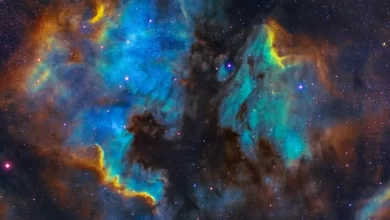Dark matter is an unknown substance that makes up most of the world and pulls on visible matter. It can’t be seen directly because it has no effect on light or other types of electromagnetic energy. Scientists think that dark matter makes up a big part of all the matter in the world, but they still don’t know what it is or how it is made. The effect of its gravity on galaxies and the large-scale framework of the universe shows that it must exist. Scientists are still trying to figure out what dark matter is and what it does. If they succeed, it could change the way we think about the world.
- Dark matter is invisible and does not interact with light or other electromagnetic radiation. This makes it extremely difficult to directly observe or detect.
- About 85% of all the matter in the world is thought to be dark matter. Only a small part of the mass of the universe is made up of ordinary matter, which includes stars, planets, and everything else we can see.
- Even though it doesn’t give off or take in light, dark matter has a gravitational pull on visible matter. Its presence can be inferred from how its gravity affects galaxies, galaxy clusters, and the large-scale structure of the universe.
- The exact nature of dark matter remains unknown. Scientists have proposed various theoretical models, suggesting that it may consist of undiscovered particles, such as Weakly Interacting Massive Particles (WIMPs) or Axions. However, these particles have not been directly detected yet.
- It is thought that dark matter makes rings around galaxies and groups of galaxies. These halos make up the gravitational structure that holds galaxies together and helps explain why they move and the way they do.
- Understanding dark matter is important if we want to know how the universe has changed and how it is put together. Its gravity affects how galaxies form and where they are located. Without it, the universe would look very different.
- Scientists use many different methods and tests to find dark matter. Some of these are particle detectors, underground labs, and observations of space. Even though a lot of work has been done, dark matter is still one of the most interesting mysteries in physics today.
- The existence of dark matter is supported by multiple lines of evidence, including observations of galactic rotation curves, gravitational lensing, and cosmic microwave background radiation.
- Dark matter is distinct from dark energy, which is another mysterious component believed to make up about 68% of the total energy content of the universe. While dark matter’s gravitational effects are felt on smaller scales, dark energy influences the overall expansion of the universe.
- The Bullet Cluster, a system of colliding galaxy clusters, provided strong evidence for the existence of dark matter. Observations of the gravitational lensing and separation of visible and dark matter during the collision supported the presence of dark matter.
- Dark matter is believed to be distributed uniformly throughout the universe, forming a cosmic web-like structure that connects galaxies and clusters of galaxies.
- Dark matter is particularly important in understanding the dynamics of dwarf galaxies. These smaller galaxies have a high ratio of dark matter to visible matter, indicating that dark matter plays a crucial role in their formation and evolution.
- Some alternative theories, like MOND, propose modifications to the laws of gravity instead of introducing dark matter. However, these theories face challenges in explaining a wide range of astronomical observations.
- Dark matter is considered non-baryonic, meaning it is not composed of the same particles as ordinary matter (protons, neutrons, and electrons). It is distinct from the matter we encounter in our daily lives.
- In rare instances, galaxies have been observed that appear to lack dark matter entirely. These “dark-matter-deficient” galaxies challenge our current understanding of dark matter and pose intriguing questions for researchers.
- Dark matter research requires collaboration between astrophysicists, particle physicists, and cosmologists. Scientists from various disciplines work together to study dark matter’s properties, search for particles, and develop theoretical frameworks.
- In addition to direct detection experiments, scientists also search for dark matter through indirect methods. These include studying high-energy cosmic rays, neutrinos, and gamma rays produced by dark matter annihilation or decay.
- Several upcoming observatories, such as the Large Synoptic Survey Telescope (LSST) and the Euclid mission, are expected to provide valuable data for studying dark matter and its effects on the universe, potentially shedding new light on its nature.
- Dark matter is thought to have originated in the early universe, shortly after the Big Bang. It is believed to have formed as a result of primordial density fluctuations, leaving an imprint on the cosmic microwave background radiation.
- Dark matter’s presence is evident in the rotation curves of galaxies. These curves show that the rotational velocities of stars and gas remain constant at large distances from the galactic center, indicating the presence of unseen mass.
- Dark matter’s existence is further confirmed through observations of colliding galaxy clusters. During these collisions, the visible matter in the clusters interacts while the dark matter passes through unimpeded, creating a separation between the two components.
- The prevailing theory suggests that dark matter is “cold” in nature, meaning its particles move relatively slowly compared to the speed of light. This helps explain its clustering behavior and the formation of the large-scale structure of the universe.
- The Large Hadron Collider (LHC), a particle accelerator at CERN, has been used to search for dark matter particles by colliding particles at high energies. While no direct detection has been made, the LHC’s experiments provide constraints on certain dark matter models.
- Dark matter is estimated to have an average density of about 0.2 to 0.3 grams per cubic centimeter throughout the universe. However, this density can vary significantly on smaller scales, such as within galaxies and galaxy clusters.
- Dark matter played a crucial role in the formation of the first galaxies. Its gravitational pull helped gather ordinary matter, allowing stars and galaxies to form within the structures created by dark matter.
- Dark matter’s presence can be indirectly observed through weak gravitational lensing. The bending of light by dark matter’s gravitational pull distorts the images of distant galaxies, providing valuable insights into its distribution.
- Scientists perform computer simulations to study the behavior of dark matter and compare their results with observational data. These simulations help refine our understanding of dark matter’s properties and test different theoretical models.
- Dark matter plays a crucial role in the formation of large-scale cosmic structures. Gravity from dark matter helps pull matter together, forming galaxy clusters, superclusters, and cosmic filaments.
- The Milky Way is believed to be embedded within a massive dark matter halo. This halo extends well beyond the visible boundaries of our galaxy and provides the gravitational framework for its structure.
- One hypothesis suggests that when dark matter particles collide and annihilate each other, they produce detectable signals such as high-energy gamma rays, neutrinos, or cosmic rays. Scientists search for these signals to indirectly probe the dark matter.
- While the prevailing explanation for dark matter is the existence of invisible particles, some alternative theories propose modifications to the laws of gravity at large scales, such as Modified Newtonian Dynamics (MOND). However, these theories have not gained wide acceptance due to various challenges.
- Dwarf spheroidal galaxies, which are small and faint, are thought to be particularly rich in dark matter. Their low luminosity and high dark matter content make them important targets for studying the properties and distribution of dark matter.
- The observed number of satellite galaxies around large galaxies like the Milky Way is lower than predicted by simulations. This discrepancy, known as the “missing satellite problem,” suggests that dark matter may have a more complex distribution or that our understanding of galaxy formation is incomplete.
- Just as ordinary matter has density fluctuations, dark matter also has perturbations in its distribution. These initial density fluctuations in dark matter eventually grow through gravity, leading to the formation of structures in the universe.
- While dark matter particles are believed to interact weakly with ordinary matter, some models propose the possibility of stronger interactions between dark matter and ordinary matter in specific conditions. However, these interactions, if they exist, are still largely hypothetical.
- Streams of stars that extend across the sky, known as tidal streams, provide valuable information about the presence and distribution of dark matter in galaxies. These streams are formed from disrupted satellite galaxies or star clusters under the gravitational influence of dark matter.
- Scientists are continually developing and refining experiments to detect dark matter directly. These experiments include deep underground detectors, high-energy particle colliders, and space-based observatories, with the goal of capturing dark matter particles or observing their indirect effects.





